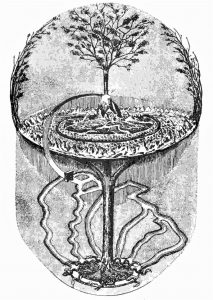Shamanic Chant – Shamanic Prayer
Our shamanic path in prayer and chanting follows the power of the ancestors.
Shamanic chant, shamanic healing song and shamanic prayer mean to be aware of the past.

A short example from norse mythology
In the language mysteries of the North, people were given the ability to speak.
In shamanic training this leads us into the 3-fold shamanic initiation of the North.
Norse mythology tells of how the god Odin listened to and formed the sounding language. (Edda, Havamal 139).
He had contemplated the runes and had learned 9 main songs.
From the well of wisdom, the language was flowing to him.
His sacrificial offering was an eye.
But that was not enough, he also acquired the poet’s potion Odhrörir (cup), which led to language.
Mimir, his uncle, is considered the primaeval singer.
He had the ability to listen to the murmur of the water, the wind, the stars, etc.
From this, the primaeval language was formed.
Odhin gazed into Mimir’s wisdom well and listened to the word.
The Edda mentions the seeress and supreme shamaness, the Völva.
She is the singer of the most important song of the Edda: „Prophecy of the Völva, a seeress“.
More about this mythology in the shaman training at the Shamanic Centre Europe

The language in shamanic training
The shamanic language in prayers and chants is of great importance to us!
In our days the word is killed, psychologised, flattened and degraded to mere communication.
The sacred truthful language can be endured by only a few.
Our shamanic ancestors experienced it as sacred and divine and it has remained so until today!
The shamanic initiation rituals of the shamans (druids and seers) required that they could attain the neck ring of Odin (Torque).
Dwarves once forged this ring for the god Odin.
To this day, it is a subtle symbol for the laryngeal centre, the speech centre, and the centre of right speech.
In Germanic times, this ring fell into the dark death realm of Hel with Baldur’s death. Everything spiritual behind speech was lost with it.
But at that time there was already the comforting prophecy that one day the word would become human to conquer death.
Then, language would awaken to new life.
But now that we are living in a time of flattened language and the inadmissible simplification of shamanic knowledge, in a time of hardened hearts, of pure intellectualism that lacks any spirituality, we are in the
midst of a new twilight of the gods.
We need to move towards the shamanism of the future.

The mythology of shamanism
Mythologies teach us a different way of dealing with death
with death rituals and death rites.
They show us transformation, movement, the cycle of life and death and the eternal.
In the ancient Egyptian empire, for example, we find hieroglyphics, which were considered the language of the gods according to the principle: „As in heaven, so on earth“.
Hieroglyphs have remained unchanged for 3000 years!
The Neoplatonist Lamblichos of Chalkis (240-320) tells us about the cult language: No one confronts the gods as a human being – but in an ecstatic trance, completely pure.
For shamans in the Shamanic Training Centre Vienna, something similar applies: the earthly personality must be left behind on a shamanic journey (shamanic death).

Shamanic mythology in ancient egypt
The ritual language in Egypt had a share in the divine.
By virtue of his office and his secret symbols (secret knowledge of shamanism), the theurgist stood on an equal footing with the gods.
The enlivening, animating word of the gods was stored in the ritual. (Today: shamanic rituals).
I will gladly tell you about ritual recitations for the living and the deceased another time.
Shamanic mythology is not beautiful – romantic narratives, but complex patterns of explanation of the world and offer a wealth of shamanic knowledge.
They have no claims to power.
However, their language is that of images and symbols, not of concepts.
It is an exciting task for each individual in shamanic training to work out the shamanic ancestral journey
and the shamanic mythology that goes with it.
We no longer live in ancient Egypt, where the initiates could look back on a documented ancestral lineage
of 10,000 years. (Herodot 490/480 BC).
But to this day they teach us respect for the mysteries of life, death and rebirth. Mythologies are images of
a complex practice of archaic societies (archaic ancestors).
Spiritual symbols and shamanic symbols are immanent in mythologies.
They inscribe in our hearts eternity, timelessness and eternal return.
In many shamanic cultures, shamanic chants and shamanic prayers were written in the language of the ancestors and remained unchanged for a long time.

The rationale of our ancestors was:
The sacred in the light worlds does not change.
Unfortunately, myths are seen as clouds floating in space and are used as broad projection surfaces.
Or we find them soullessly packaged in scientific interpretations.
Seen from a shamanic perspective, they are a treasure to be guarded and which we must reclaim.
In today’s world, time passes very quickly. The present is shrinking and the past is relegated to the museum in favour of a new world order.
Shamans at the Shamanic Centre Austria connect with multi-layered mythologies of times past, enriching our here and now.
Regina Hruska Stephanie König Contact



